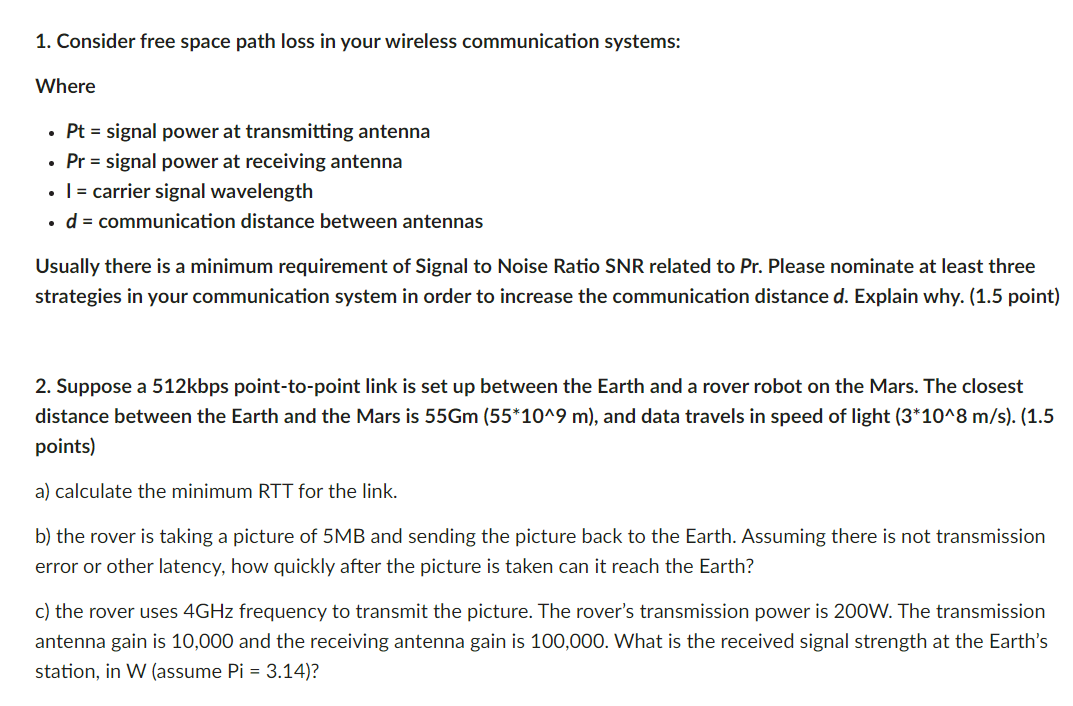

1. Consider free space path loss in your wireless communication systems: Where Pt = signal power at transmitting antenna Pr = signal power at receiving antenna . ] = carrier signal wavelength d = communication distance between antennas Usually there is a minimum requirement of Signal to Noise Ratio SNR related to Pr. Please nominate at least three strategies in your communication system in order to increase the communication distance d. Explain why. (1.5 point) 2. Suppose a 512kbps point-to-point link is set up between the Earth and a rover robot on the Mars. The closest distance between the Earth and the Mars is 55Gm (55*10^9 m), and data travels in speed of light (3*10^8 m/s). (1.5 points) a) calculate the minimum RTT for the link. b) the rover is taking a picture of 5MB and sending the picture back to the Earth. Assuming there is not transmission error or other latency, how quickly after the picture is taken can it reach the Earth? c) the rover uses 4GHz frequency to transmit the picture. The rover's transmission power is 200W. The transmission antenna gain is 10,000 and the receiving antenna gain is 100,000. What is the received signal strength at the Earth's station, in W (assume Pi = 3.14)? 3. Calculate the total time required to transfer a 1000-KB (KB: Kilo-Byte) file in the following cases, assuming a Round Trip Time (RTT) of 50ms, a packet size of 1KB, and an initial 2*RTT of handshaking to establish the connection before data is sent (1 point): a) the bandwidth is 1.5Mbps (million bits per second), and data packets can be sent continuously. b) the bandwidth is still 1.5Mbps, but we use a protocol with ACK to improve reliability. After we finish sending each data packet we must wait one RTT to receive ACK before sending the next. 4. What is the theoretical maximum capacity (in Gbps) for a wireless link, with spectrum ranging from 30GHz to 60GHz, and with an SNR of 20dB? (1 point) 1. Consider free space path loss in your wireless communication systems: Where Pt = signal power at transmitting antenna Pr = signal power at receiving antenna . ] = carrier signal wavelength d = communication distance between antennas Usually there is a minimum requirement of Signal to Noise Ratio SNR related to Pr. Please nominate at least three strategies in your communication system in order to increase the communication distance d. Explain why. (1.5 point) 2. Suppose a 512kbps point-to-point link is set up between the Earth and a rover robot on the Mars. The closest distance between the Earth and the Mars is 55Gm (55*10^9 m), and data travels in speed of light (3*10^8 m/s). (1.5 points) a) calculate the minimum RTT for the link. b) the rover is taking a picture of 5MB and sending the picture back to the Earth. Assuming there is not transmission error or other latency, how quickly after the picture is taken can it reach the Earth? c) the rover uses 4GHz frequency to transmit the picture. The rover's transmission power is 200W. The transmission antenna gain is 10,000 and the receiving antenna gain is 100,000. What is the received signal strength at the Earth's station, in W (assume Pi = 3.14)? 3. Calculate the total time required to transfer a 1000-KB (KB: Kilo-Byte) file in the following cases, assuming a Round Trip Time (RTT) of 50ms, a packet size of 1KB, and an initial 2*RTT of handshaking to establish the connection before data is sent (1 point): a) the bandwidth is 1.5Mbps (million bits per second), and data packets can be sent continuously. b) the bandwidth is still 1.5Mbps, but we use a protocol with ACK to improve reliability. After we finish sending each data packet we must wait one RTT to receive ACK before sending the next. 4. What is the theoretical maximum capacity (in Gbps) for a wireless link, with spectrum ranging from 30GHz to 60GHz, and with an SNR of 20dB? (1 point)








